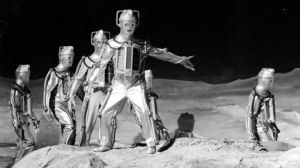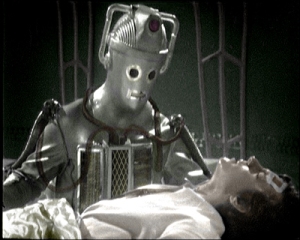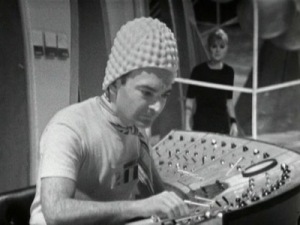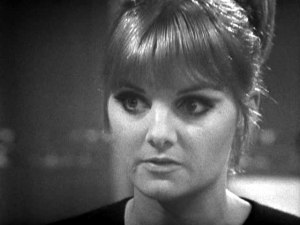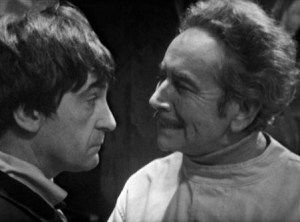One of the most frustrating aspects of 21st Century Doctor Who is the almost complete absence of cliff hangers. Very few stories have extended beyond one episode. In a clear nod to William Hartnell era stories, the Series 7 story The Crimson Horror ended with a direct lead-in to the next story, Nightmare in Silver. Arriving back in present-day London, the companion Clara meets with the children she babysits, Angie and Artie, who blackmail her into taking them on her next adventure in the TARDIS.
In celebration of the great cliff hangers of Classic Series Doctor Who this article will briefly examine the Top 10 Cliff Hangers of the Sixties. So as not to reinvent the wheel, The Doctor Who Mind Robber has directly quoted the episode ending summaries from David J Howe and Stephen James Walker’s seminal book The Television Companion. No copyright infringement is intended.

David J Howe & Stephen James Walker’s The Television Companion was published in 2003 by Telos Publishing
10. Fury From the Deep – Episode 3
“Maggie Harris and Robson, both infected by the weed creature, meet on the beach. The former tells the latter that he will obey his instructions. Then she turns and walks straight out into the sea, eventually becoming completely submerged beneath the waves”.
The horror of this cliff hanger is the apparent suicide of Maggie Harris, the wife of one of the base employees. It is not until several episodes later that it becomes evident that Mrs Harris is still alive. Incidentally, Fury From the Deep is one of the few Doctor Who serials in which no one dies.
Unfortunately all episodes of Fury From the Deep have been lost, however the soundtrack, telesnaps and Loose Cannon’s excellent reconstruction brilliantly convey the horror.
9. An Unearthly Child – Episode 1
“The TARDIS arrives on a Palaeolithic landscape, over which falls the shadow of a man”.
This is the cliff hanger to the very first episode of Doctor Who and it’s the first time that the television viewers see the TARDIS materialize. The ominous shadow of a man in the barren landscape is both frightening and unexpected.
8. The Mind Robber – Episode 1
“The TARDIS is in flight, the travellers having apparently escaped from the void. A low, throbbing hum is heard which grows in intensity until it is unbearable. Suddenly the TARDIS explodes. The Doctor spins away through space while Jamie and Zoe are left clinging to the console as it is engulfed in swirling mist.”
The end of the first episode of The Mind Robber is absolutely brilliant. This is the first time in Doctor Who that the TARDIS explodes and the crew is left floating perilously in space. The image of Zoe clinging onto the TARDIS console has become iconic for all the wrong reasons. Her tight sparkly cat suit clings to her body as the camera focuses on her bottom.
7. The Massacre – Episode 3
“The Abbot of Amboise lies dead in the gutter, a crowd of angry Catholics gathering around his body. When Steven protests that the Huguenots were not responsible, Roger Colbert incites the crowd against him. Steven flees for his life through the Paris streets …”
The Massacre sees William Hartnell play two roles – the Doctor and the evil Abbot of Amboise. Both characters are absolutely identical in appearance however the audience and companion Steven are unaware if the Doctor is masquerading as the Abbot, or if the Doctor and the Abbot are two different people. It’s for that reason that this cliff hanger is so powerful as it is not clear if it is the Doctor or the real Abbot who is dead.
The Massacre is another of the serials which unfortunately has all episodes missing. As discussed in Fury From the Deep, this does not distract from the potency of the ending.
6. The Tenth Planet – Episode 4
“The Doctor returns to the TARDIS, closely followed by Ben and Polly. The ship’s controls move of their own accord and the Doctor collapses to the floor. His companions enter and, before their astonished eyes, the Doctor’s face transforms into that of a younger man”.
This episode ending is of course Doctor Who’s first regeneration. The First Doctor, William Hartnell, collapses and with exceptional special effects for the era, his face is transformed into that of the Second Doctor, Patrick Troughton. The audience must wait until the next episode to see all of the new Doctor’s body and to experience his personality. There was no precedent for a change of the lead character in such a manner, and the audience was left stunned as they anticipated the new Doctor’s personality and physical appearance.
Episode 4 of The Tenth Planet has been lost however an amateur film was taken of a television screen during the broadcast of the episode. The episode has also been recently animated and will be released on DVD next month.
5. The Dalek Invasion of Earth – Episode 1 and Episode 6
“The Doctor and Ian, menaced by a group of Robomen, prepare to escape by diving into the Thames. As they turn, they see rising slowly from the water the familiar shape of a Dalek.” (Episode 1)
“The TARDIS dematerialises and, comforted by David, Susan moves away. Her TARDIS key lies discarded on the ground, with an image of a starscape superimposed …” (Episode 6)
The cliff hanger of episode 1 derives its force from both the iconic background of the Thames River and the emergence of Doctor Who’s first return monsters, the Daleks. Having been so well received in their first story, the return of the Daleks was eagerly anticipated by fans. As was the common practise in early Doctor Who stories, the monsters rarely appeared on-screen until the end of the serial’s first episode.
The episode six ending marked the first departure of a companion in Doctor Who. Just prior to the episode’s end the Doctor gave an impassioned oration to his grand-daughter Susan whom he was effectively deserting on the 21st Century Earth.
4. Planet of Giants – Episode 2
“After cleaning Farrow’s blood from the patio stones outside, Smithers goes into the laboratory to wash his hands, unaware that the Doctor and Susan are hiding in the water outlet from the sink. As a helpless Ian and Barbara watch, he fills the sink with water, washes, and then pulls out the plug”.
The brilliance of the episode 2 cliff hanger of Planet of the Giants is that it successfully made the mundane frightening. Watching a plug pulled from a sink and water cascading down a drain would ordinarily be exciting as watching the kettle boil. Our heroes, however, have been shrunk to less than an inch in height and are as vulnerable as an ant is to the heavy boot of a human. The companions Ian and Barbara, together with the audience, are left paralysed with fear at the imminent drowning of the Doctor and Susan.
3. The Daleks – Episode 1
“Exploring their apparently deserted city, Barbara encounters one of the Daleks and is menaced by its telescopic sucker arm.”
As outlined in The Dalek Invasion of Earth, it was standard practice in early Doctor Who for the monsters not to emerge until the cliff hanger of the first episode. This absolutely iconic ending sees Barbara pinned to a wall in fear as a Dalek’s sucker arm menaces her. The audience has not yet seen the rest of the Dalek’s body however the expression on Barbara’s face paints a picture of a horrifying spectacle.

Barbara is pinned against the wall in fear during the Daleks’ first appearance in Doctor Who on 21st December 1963
2. The War Games – Episode 1 and Episode 10
“In the First World War zone the Doctor has been found guilty of spying against the English forces and is tied up before a firing squad. Captain Ransom brings his men to order, tells them to present arms and opens his mouth to give the order to fire. A shot rings out and the Doctor grimaces” (Episode 1)
“A still protesting Doctor spins away through a dark void to begin his sentence of exile on Earth with a new appearance. His face is shrouded in shadow …” (Episode 10)
By the time the first episode of The War Games was broadcast Patrick Troughton’s decision to leave the role of the Doctor had been made public. Whilst history had shown that the Doctor always escaped serious harm, the audience could not be certain that his luck hadn’t finally ended. Perhaps he would be killed by the firing squad and regeneration was imminent?
Episode 10 is perhaps my all-time favourite as so many mysteries about the Doctor’s past are answered. His forced regeneration at the episode’s end is chilling but perhaps not as sad as Jamie and Zoe’s departure earlier in the episode. The monochrome era of Doctor Who was at an end and things would never be the same again.
1. The Invasion – Episode 6
“The Cybermen emerge from the sewers and march through the streets of London as the invasion begins.”
The Cybermen’s emergence from the sewers of London and their march down the steps of St Paul’s Cathedral is justifiably iconic. By placing the monsters in an easily recognizable London landscape genuine fear would have been instilled in the audience. Although the Daleks had visited tourist spots such as Westminster Bridge in The Dalek Invasion of Earth, the Cybermen were in current day London. This wasn’t one of the Daleks’ futuristic tales but rather a genuine invasion in our own time. As Jon Pertwee said, there’s a “Yeti on the Loo in Tooting Bec”.
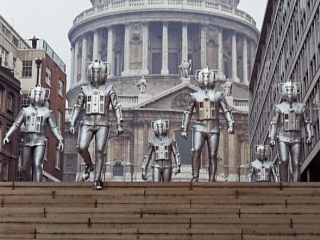
Arguably the most iconic cliff hanger in classic series Doctor Who. The Cybermen on the steps of St Paul’s Cathedral
TOMORROW – DAY 47 – The 10 Greatest Billy Fluffs
YESTERDAY – DAY 49 – The 10 Least Remembered Monsters of the Sixties
Vivien Fleming
©Vivien Fleming, 2013.












